
MUSEUM OF NEW MEXICO FOUNDATION SUMMER 2023
in the Railyard
A Season of Contemporary Art Vladem Contemporary Opens
MEMBER NEWS CONTRIBUTORS
LETTER TO MEMBERS
BOARD OF TRUSTEES
THE VLADEM CONTEMPORARY
MUSEUM OF INDIAN ARTS AND CULTURE
MUSEUM OF INTERNATIONAL FOLK ART
NEW MEXICO MUSEUM OF ART
NEW MEXICO HISTORY MUSEUM
NEW MEXICO HISTORIC SITES
OFFICE OF ARCHAEOLOGICAL STUDIES
OUR MISSION
The Museum of New Mexico Foundation supports the Museum of New Mexico system, in collaboration with the Museum of New Mexico Board of Regents and the New Mexico Department of Cultural Affairs. The Foundation’s principal activities are fund development for exhibitions and education programs, retail and licensing programs, financial management, advocacy and special initiatives.
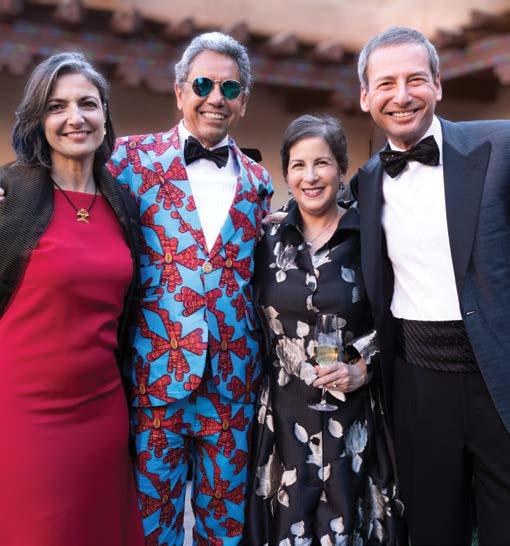
We serve the following state cultural institutions:
• Museum of Indian Arts and Culture
• Museum of International Folk Art
• New Mexico History Museum
• New Mexico Museum of Art
• New Mexico Historic Sites
• Office of Archaeological Studies
TO GIVE 1 2 3 8 10 12 14 16 18 20 21
CORPORATE PARTNER SPOTLIGHT WAYS
Mariann Lovato, Managing Editor
Carmella Padilla, Writer and Editor
Steve Cantrell, Writer
Jennifer Levin, Writer Saro Calewarts, Designer
Cover: Southwest view of the New Mexico Museum of Art’s Valdem Contemporary. Rendering © DNCA Architects + StudioGP.
/museumfoundation /museumfoundation
Above: Left to right, Alina Boyko, Devendra Contractor, Ellen Vladem and Bob Vladem. Photo © Jane Phillips. Opposite: Photo by Saro Calewarts.
Table of Contents
Dear Members,
This summer, we will celebrate a significant milestone for the New Mexico Museum of Art.
On Saturday and Sunday, September 23 and 24, the museum will open the Vladem Contemporary, a second location in Santa Fe’s Railyard Arts District. The new 35,000-square-foot museum building features two galleries, a dedicated education classroom, artist studio, collections storage, and a spectacular outdoor terrace with views of the historic downtown area and the Sangre de Cristo mountains.
Our feature story, beginning on page 3, describes the Vladem Contemporary in wonderful detail. Highlights include its innovative, public-facing art—from the Leo Villareal light installation, to the Window Box and video window, to the admission-free central lobby. The inaugural exhibition, Shadow and Light, will showcase sculpture, video, installations, holograms, mixed-media, etching, photography and more by 24 contemporary artists. Museum of New Mexico Foundation members will be invited to an exclusive preview of the new building on Friday, September 22, a day before the Vladem Contemporary opens to the public. I hope you will join us in celebrating this grand opening. A save the date email and formal invitation are forthcoming as benefits of your museum membership.
Contemporary is the theme for this entire issue of Member News as we explore the works of living artists on view at all four state museums in Santa Fe and the New Mexico Historic Sites. Learn about glass art at the Museum of Art’s 1917 building on the Plaza and contemporary Native art at the New Mexico History Museum’s Indian Market centennial exhibition.
On Museum Hill, the Museum of Indian Arts and Culture debuts a Navajo textile exhibition in July that features both historic and contemporary weavings. And giant alebrijes, fantastical figures newly created by four contemporary master cartoneros (papier-mâché artists), will spill onto Milner Plaza from the Museum of International Folk Art.
Art in Public Places, a program of New Mexico Arts, a division of the Department of Cultural Affairs, is the very definition of contemporary art. Public art works are featured at Coronado Historic Site, Jemez Historic Site, Fort Selden Historic Site and the Bosque Redondo Memorial at Fort Sumner Historic Site. The latter site will launch a new artist-in-residence program this summer that will bring two artists to live and work in Fort Sumner.
I urge you to visit all four of our state museums in Santa Fe and historic sites throughout New Mexico this summer. The exhibitions and programs you will enjoy are made possible by your generous support of the Foundation and Museum of New Mexico system. Thank you!
Sincerely,
Jamie Clements President/CEO

Museum of New Mexico Foundation members will be invited to an exclusive preview of the new building before the Vladem Contemporary opens to the public.
—Jamie Clements
museumfoundation.org | 1
Museum of New Mexico Foundation Trustee
Michael Ogg is known as a tireless advocate for the New Mexico Museum of Art.
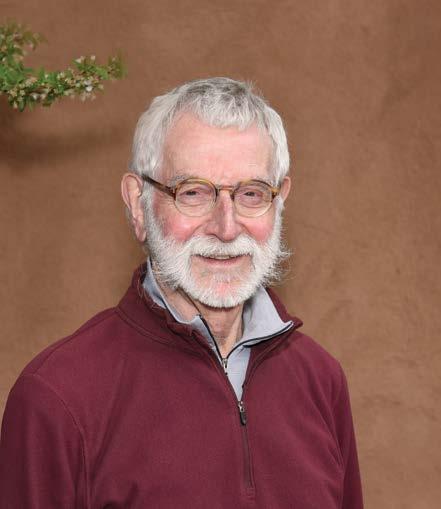
Since moving to Santa Fe in 1978, both he and his wife Barbara have supported the museum in myriad ways, including Barbara’s former roles as a docent and co-chair of the Fine Arts Committee. In the 1980s and 1990s, the couple’s passion for collecting contemporary art translated to Friends of Contemporary Art membership and donations of works by such artists as Fritz Scholder, Alan Graham, Paul Sarkisian and Terry Conway. Their membership in The Circles and generous gifts to exhibitions, education and the Centennial Campaign have bolstered all aspects of the museum.
Michael, a trustee since 2019, heads the museum’s Advancement Committee, playing a major role in the push to create the Vladem Contemporary. The new museum, he says, represents "the willingness of the Museum of Art to think outside the box with regard to new, useful and exciting places in which to engage the public it serves and to increase opportunities for regional artists.”
Board of Trustees 2022–2023
OFFICERS
Frieda Simons, Chair
Cathy A. Allen,Vice Chair
Maria Gale, Vice Chair
Michael Knight, Treasurer
Kate Moss, Secretary
VOTING TRUSTEES
Lorin Abbey
Allan Affeldt
John Andrews
Cynthia Bolene
William Butler
Julia Catron
Joe Colvin
Rosalind Doherty
Diane Domenici
John Duncan
Gwenn Djupedal
Eric Garduño
Robert Glick
Guy Gronquist
Pat Hall
David Hawkanson
Susie Herman
Ruth Hogan
Peggy Hubbard
Edelma Huntley
Bruce Larsen
Christine McDermott
Dan Monroe
Michael Ogg, M.D.
Dennis A. O’Toole, Ph.D.
Sara Otto
Robert Reidy, M.D.
Natalie Rivera
John Rochester
Wilson Scanlan
Harriet Schreiner
Judy Sherman
Courtney Finch Taylor
Margo Thoma
Robert Vladem
Laura Widmar
David Young
Sandy Zane
Ellen Zieselman
ADVISORY TRUSTEES
Victoria Addison
Keith K. Anderson
Robert L. Clarke
Stockton Colt
France Córdova
Liz Crews
Jim Davis
Joan Dayton
Greg Dove
George Duncan
Kirk Ellis
Carlos Garcia
Leroy Garcia
J. Scott Hall
Steve Harris
Stephen Hochberg
Rae Hoffacker
Barbara Hoover
Kent F. Jacobs, M.D.
David Matthews
Helene Singer Merrin
Beverly Morris
Blair Naylor
Mark Naylor
Patty Newman
Jane O’Toole
Michael Petitt
Kathleen Pugh
Jerry Richardson
Chris Ryon
J. Edd Stepp
Nancy Meem Wirth
Claire Woodcock
HONORARY TRUSTEES
Anne Bingaman
Jim Duncan Jr.
John Marion
Edwina Milner
Carol Warren
Eileen A. Wells
TRUSTEES EMERITI
Saul Cohen
Bud Hamilton
James Snead
MUSEUM OF NEW MEXICO FOUNDATION
Top: Museum of New Mexico Foundation Trustee Michael Ogg.
Photo by Saro Calewarts.
Opposite: Lee Bull, Sternbau No. 2, 2007. Stainless steel, acrylic, crystal, glass beads, aluminum and steelchain. Tia Collection. Photo courtesy of Galerie Thaddaeus Ropac, London-Paris-Salzburg.
TRUSTEE FEATURE 2 | museumfoundation.org
FORM and PRACTICE
The Vladem Contemporary Connects Old and New

The passage of time renders old what was once new.
Consider the New Mexico Museum of Art, which opened in 1917 to showcase contemporary works made by living artists.
Robert Henri, Gerald Cassidy and Kenneth Chapman were among the first to contribute paintings to the museum’s collection, creating works specifically for the new Pueblo Revival-style building on the northwest corner of the Santa Fe Plaza.
Today, explains Mark White, the museum’s executive director, “Those
same paintings are considered modern, rather than contemporary art.”
The collection has grown tremendously since 1917. But the museum —a devoted guardian of the older works—is nearly out of space for new acquisitions. Just as pressing: the Plaza building’s technological capabilities don’t serve 21st-century artists. Indeed, no one could have anticipated LED light installations or live-streamed performance art in 1917, or even in 1980, when the Plaza building was expanded. These limitations have imperiled the museum’s founding mission.
Until now. When the New Mexico Museum of Art’s Vladem Contemporary opens in the Santa Fe Railyard this September, the museum will embrace and engage anew the artistic frontiers envisioned by its founders.
There’s no ideological or aesthetic division between the sites. As a whole, the new Railyard building and the original Plaza building should be considered two wings of the same Museum. “We’ll be able to show contemporary art in a more versatile way,” White says.
Preserving Community History
The two-story Vladem Contemporary on the corner of Guadalupe Street and Montezuma Avenue is one of the Railyard District’s most historic structures. The original ground-floor section was erected in 1936 next to the train depot, on the site of an old coal field. It was a warehouse for the Charles Ilfeld Company, which closed in 1959. The New Mexico State Records Center took over the building in 1960, and when its longtime director Joseph F. Halpin died in 1987, the building was renamed in his honor.
The New Mexico State Records Center moved to a state-of-the-art facility in the 1990s, and the state Department of Cultural Affairs began using the Halpin Building for storage and office space. In 2013, plans to store some of the New Mexico Museum of Art’s ever-expanding collection there soon transformed into plans for a new museum building.
In 2016, as the museum prepared for its 100th anniversary celebration, the Museum of New Mexico Foundation kicked off a $12.5 million Centennial Campaign to enhance its public-private partnership with the State of New Mexico and support the museum’s vision for a second location.

6 | museumfoundation.org
Northeast view of the Vladem Contemporary. Rendering © DNCA Architects and StudioGP.
To support the Vladem Contemporary, contact Kristin Graham at Kristin@museumfoundation. org or 505.216.0826.
“We were equal partners in funding the construction, to the tune of about $10 to $11 million each,” says Jamie Clements, the Foundation’s president and CEO. “The state contribution came through capital outlay appropriated by the state legislature. In addition, the state has added $1 million in annual operating funds for the Museum of Art to accommodate the additional staff needed for the Vladem. The Foundation, in turn, has raised over $2.5 million for all inaugural year programming for both the Vladem and the 1917 building.”
Robert J. and Ellen R. Vladem made the lead $4 million gift to the Centennial Campaign. “Art changes people’s lives. It affects how they see the world,” Robert Vladem says. “I can’t think of a better way for us to have spent our money. Being a state building, it’s important that you can see amazing things inside the museum, but even more importantly, there will be incredible art installations that you can see from the outside. You can get a daily dose of art without even going into the building.”
The Office of Archaeological Studies performed the site survey before construction began in 2021. Most of the findings were from the railroad era and the area’s days as a coal field. The most significant issue that arose during the planning stages was over the “Multi-Cultural Mural” on the east side of the building, which was deteriorating.
The mural was first painted by a group of New Mexico artists in 1980. It soon began to fade, and one of the artists, Gilberto Guzman, repainted the piece in 1990. Guzman and community activists didn’t want the mural removed as the Halpin Building was remodeled, but the mural was deemed by the state to be too degraded to restore. After a protracted negotiation, Guzman agreed to re-create the mural on several panels, to hang in the Vladem Contemporary’s lobby in perpetuity.
Anatomy of an Art Museum
The Halpin Building was perfectly suited to become an art museum, says Dierdre Harris, senior associate architect with DNCA, one of the two firms that designed the Vladem Contemporary. “The proportions are beautiful and timeless.”

Led by DNCA principal architect Devendra Contractor, the design team leaned into Santa Fe’s tradition of masonry load-bearing architecture, preserving the old warehouse rather than tearing it down. The additions, which include a second floor, “honor the old and the new,” says Graham Hogan, principal of the second architectural firm, StudioGP. “It’s a contemporary take on the stuccoed adobe that’s synonymous with Santa Fe.”
The building was expanded from 20,000 square feet to 35,000 square feet, with 4,100 square feet of storage. Harris describes the renovated structure as “two very long bars that have a glass opening in between them, sitting on a concrete base. It’s not exactly proportional.”
Entry is from Montezuma Avenue on the north side, or from the train depot on the south; the two halves of the building are connected by a central lobby. A gift shop on the depot side is connected to the rest of the building
museumfoundation.org | 5
Yayoi Kusama, Pumpkin, 2015. Stainless steel, urethane. Photo courtesy of the Tia Foundation.
the new Railyard building and the original Plaza building are two wings of the same museum.
by a breezeway that features a permanent LED light installation by the internationally renowned Albuquerque-born artist Leo Villareal.
“He develops patterns based on natural phenomenon—cloud formations, wave dynamics,” says museum director Mark White. “The result often looks like a star field.”
The Montezuma Avenue side of the building is fronted by an eight-byfive-foot Window Box that will showcase installations by New Mexico artists. The first featured artists are Christina Gonzales and Morgan Barnard, members of Vital Spaces, a Santa Fe-based collective that will select artists during the new museum’s first year.
“The windows will be illuminated at night, so there will always be something to see,” White says.
The ground floor contains a 5,000-square-foot main gallery and a new 2,300-square-foot education room for classes, lectures and workshops. “We’ve never had a dedicated education space in the Plaza building, and this is going to be a real art room, where people can do messy projects,” White says. Additionally, the classroom’s east-facing wall is a glass pane onto which artist videos will be projected in the late afternoons and early evenings, visible from the street.
“The Vladem is one of the most innovative contemporary art venues in the country for public-facing art,” says Clements. “There will be outward-facing art projects for all to enjoy, and the opportunity to pass through the central lobby without paying admission.”
Upstairs is over 4,000 square feet of exhibition space and a dedicated artist-in-residence studio. The latter will host five artists each year for two-week residencies that feature public programs. Finally, a rooftop deck with dramatic views of downtown Santa Fe and the Sangre de Cristo Mountains offers a rest area for museum-goers, a gathering spot for art lovers and a singular space for private events.
“We want the Vladem Contemporary to become a social hub in the Railyard, not just for the summer tourist crowd but for the community that lives here 365 days a year,” White says. “We’re hoping to add a lot more to the cumulative energy that’s already present in the Railyard District.”

Building an Artistic Legacy
Shadow and Light, the inaugural exhibition at the Vladem Contemporary, features works of sculpture, video, installation, hologram, mixed-media, etching, photography and more by 24 artists, including Judy Chicago, Nancy Holt, August Muth, Virgil Ortiz, Helen Pashgian and Erika Wannemacher. The show contains objects from the museum’s collection as well as pieces on loan from the artists.
6 | museumfoundation.org
The Vladem is one of the most innovative Contemporary art venues in the country for public-facing art.
The second-floor terrace at the Vladem Contemporary. Rendering © DNCA Architects and StudioGP.
The Vladem Contemporary opens exclusively to members on Friday, September 22.
For information and updates about the Members-only Preview and Grand Opening Celebration, visit museumfoundation.org.
While most of the work is by living artists, some are from artists of the past, such as abstract painter Agnes Martin, whose striking and sparse grid patterns had a significant influence on art after 1960.
Shadow and Light “examines the classic idea of New Mexico light influencing artists for generations, how contemporary artists have used light as a physical medium for their work as well as sort of metaphorical construct,” White says.
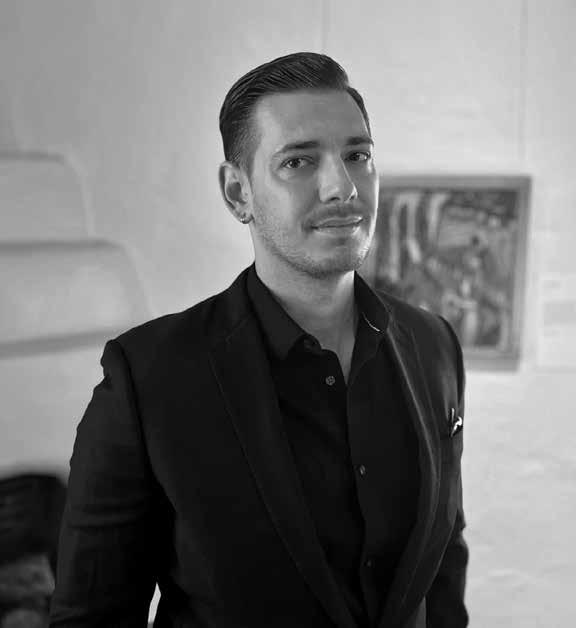
Christian Waguespack, the museum’s head of curatorial affairs and curator of 20th century art, described the exhibition as an interesting exercise in figuring out where different parts of the collection might belong, particularly as we proceed deeper into the new century.
“I think it’s a nice balance between the older pieces in the collection and how we’re looking at contemporary art being made right now,” Waguespack says. “Contemporary art isn’t a clean cut starting in the 1960s. We saw that there were contemporary pieces that spoke to the kind of trends or concerns in art history that the Plaza building would keep up a bit more robustly. And there were some works from the 1950s that belong with the contemporary work. It got us thinking about what kinds of stories we wanted to tell in each space, what kind of programming we might be engaged in, moving forward. While the collection is one collection, various elements are going to start taking on their own identities in particular ways, which is fun.”
Shadow and Light will be on display through April 2024. After that is Off-Center: New Mexico Art, 1970-2000, which highlights artists who relocated to New Mexico in the last decades of the 20th century, including Larry Bell, T.C. Cannon, Gus Foster and Fritz Scholder. They worked in land art, digital art, minimalism, neo-expressionism and pop art, among other genres that didn’t yet exist when painters first gravitated here. The exhibition will be shown in three rotations throughout the year, in order to capture as much of the thematic breadth of each featured artist as possible. Each installation will include video interviews with the artists.
“In the same way we are responsible for holding the 20th century legacy, we’re very much responsible for holding that artistic legacy moving forward,” Waguespack says. “Although we’re not always going to connect them directly, our exhibitions in both buildings will make connections between pieces that reference historic moments, and pieces that fit into the contemporary moment. The two buildings speak to our history in terms of the art, but the museum was always meant to be a makers’ space, even early in our history. Artists were always supposed to come here to make and exhibit new work. Practice has always been important.”
museumfoundation.org | 7
Christian Waguespack, head of curatorial affairs and curator of 20th century art at the New Mexico Museum of Art. Photo courtesy New Mexico Department of Cultural Affairs.
Join the Celebration!
Textiles Transformed
Exhibition Enlivens Diné Weaving Traditions
Textiles both contemporary and historic—some on view for the first time— are the focus of Horizons: Weaving Between the Lines with Diné Textiles, opening to members July 15 at the Museum of Indian Arts and Culture. The juxtaposition of past and present, according to the exhibition cocurators, “expresses the cultural legacy and continued vibrancy of weaving traditions in the American Southwest."
“Exhibiting historical and contemporary weaving together shows that it is a living art form and an ongoing cultural practice,” says co-curator Hadley Jensen.

Co-curator Rapheal Begay (Diné) adds, “It brings the past into visual conversation with the present and provides an opportunity for Diné to reconnect with the living legacies of our ancestors.”
Beyond the beauty of Navajo textiles, the exhibition illuminates both their individual and communal significance. “Many weavers feel their textiles are living, breathing, animated beings (rather than inanimate objects),” says Jensen. “I often hear that weavings have a life force of their own, and they are imbued with this through the process of their creation.”
Perhaps more than anything, Begay says, the exhibition explores how the ecological relationship between the land and the Diné people fuels their creativity.
Works by Begay, who is also a photographer, are also included in the exhibition. Like weaving, he says, photography is a way “of engaging with place and providing a connection to Dinétah (the Navajo homeland).” Describing himself as a visual storyteller, Begay says, “With my camera, I move about land and community documenting relationships, visual blessings and political gatherings within the Navajo Nation.”
The exhibition again highlights the Museum of Indian Arts and Culture’s commitment to inclusivity and collaboration, ensuring that Indigenous people are actively involved in determining exhibition content.
In addition to Jensen and Begay, Horizons was shaped by a Diné advisory committee of contemporary weavers, educators, scholars and cultural practitioners. Among other things, they provided new interpretation and label copy for the museum’s historic textile collection. Their collective expertise engages museum visitors with a deeper understanding of Diné textile artistry and ways of knowing past, present and future.
To support the Museum of Indian Arts and Culture, contact Lauren Paige at 505.982.2282 or Lauren@museumfoundation.org.
8 | museumfoundation.org
Artist once known (Diné). Chief Blanket, 1875-1880. Handspun wool, indigo dye, vegetal dye. Collection of the Museum of Indian Arts and Culture. Gift of Mrs. Philip B. Stewart. Photo courtesy Museum of Indian Arts and Culture.
An illustrated exhibition catalogue with essays by artists and scholars and edited by Jensen will be published by the Museum of New Mexico Press. It is expected to be released in 2024.
Generous support for Horizons: Weaving Between the Lines with Diné Textiles, was provided by a $75,000 grant from the Terra Foundation for American Art. Additional support from France A. Córdova and Christian J. Foster; Tom and Mary James, founders of the James Museum of Western and Wildlife Art; Shiprock Santa Fe; and the New Mexico Department of Cultural Affairs.
What's New in the Collection
The Friends of Indian Art is making a significant addition to the museum’s collection of contemporary Diné textiles, contributing the funds to commission a weaving from renowned Diné weaver Lynda Teller Pete.

Pete, a fifth-generation weaver, was selected by the group with museum guidance. She is both an artist and educator who has dedicated her life to the preservation of Diné weaving traditions. Her sister Barbara Teller Ornelas is also an acclaimed Diné weaver. Both were recently awarded the 2023 MIAC Legacy Award at the museum’s annual Native Treasures Art Market.
The entire process of Pete’s weaving the new textile will be videotaped for educational purposes. When complete, both the weaving and video will be displayed in the museum’s acquisitions gallery.

museumfoundation.org | 9
Lynda Teller Pete (Diné). Photo courtesy Museum of Indian Arts and Culture.
Artist once known (Diné). Shoulder Blanket or Saddle Blanket, 1870-1880. Handspun wool, commercial wool yarn, indigo dye, raveled yarn, cochineal dye. Collection of the Museum of Indian Arts and Culture. Photo courtesy Museum of Indian Arts and Culture.
It brings the past into visual conversation with the present and provides an opportunity for Diné to reconnect with the living legacies of our ancestors.
Experiencing Papier-Mâché
Cartonería Giants Overtake the Town
This summer, the Museum of International Folk Art's popular exhibition, La Cartonería Mexicana: The Art of Paper and Paste, extends to Milner Plaza.
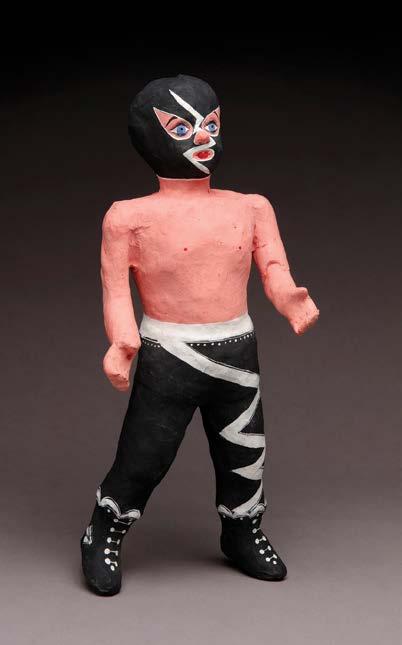
"Visitors will enjoy our outdoor exhibition of imaginary cartonería creatures called alebrijes, as well as other fanciful animals," says Nora Dolan, who organized the outdoor project. Dolan also co-curated La Cartonería with Leslie Fagre, the museum's director of education.
Four contemporary master cartoneros (papier-mâché artists) from Mexico City spent months designing and building their alebrijes, often working with partners in their communities. The artists include Perla Miriam Salgado Zamorano, Alejandro Camacho Barrera, Alberto Moreno Fernández and Edgar Israel Camargo Reyes. The works were borrowed from a much larger exhibition curated by the Mexican Cultural Center in DuPage, Illinois.
“This installation is a source of pride for the artists, their families and the people of Mexico,” says Fernando Ramirez, president and founder of the Mexican Cultural Center. “They are excited to share their work in Santa Fe.”
Exhibition funding received a jump start from Coreen Cordova, a Friends of Folk Art board member. “As a lifetime collector of Mexican folk art, the Cartonería exhibition just spoke to me,” she says. “I was so happy to open my home for the [Museum of New Mexico] Foundation’s fundraising event and just thrilled we raised more than $20,000.” Los Amigos del Arte Popular provided an additional $7,500 grant for the outdoor installation.
Another exhibition supporter is the James Beard Award-winning chef Fernando Olea, owner of Santa Fe’s Sazón restaurant. His contribution of fancifully-themed hors d’oeuvres took Cordova’s event over the top. Olea described his involvement, saying, “Because food is my art, it’s similar to the papier-mâché in Cartonería, visually fun, yet impermanent.”
This summer, another giant alebrije will delight visitors to the Santa Fe Public Library’s southside branch, where they will be greeted by a fifteenfoot figure by Mexican artist Oscar Becerra Mora. The Friends of Folk Art stepped in again with a grant to bring the figure from the Mexican Cultural Center in Denver.
To support the Museum of International Folk Art contact Laua Sullivan at 505 216.0829 or Laura@museumfoundation.org.
Wrestler on Dark Background. Collection of Museum of International Folk Art. Photo © Addison Doty.
10 | museumfoundation.org
Private donations via the Museum of New Mexico Foundation also funded a traveling exhibition throughout Santa Fe and northern New Mexico through the end of May. Post Fiesta Wares, a papier-mâché installation of alebrijes created by Santa Fe artist Rick Phelps, was showcased by Axle Contemporary, a mobile art space inside a custom retrofitted 1970 aluminum delivery van.
Phelps describes his work as “sculptures drawing on the traditional Mexican arts of cartonería and piñata, incorporating an ever-changing array of materials, references and characters, drawing upon Pop, Punk, Folk, Funk and other vernacular traditions.”

The Museum of International Folk Art’s bilingual educator Kemely Gomez will continue to engage the public with cartonería art-making activities and learning opportunities throughout the run of the exhibition, which is on view through November 3, 2024.
What's New in the Collection
The late Carlos José Otero was born in Los Lunas, New Mexico, in 1947. In addition to being a santero (saint maker), Otero was an Albuquerque Public Schools teacher, a poet, musician and composer, and genealogist. In 2018, he was awarded the Spanish Colonial Arts Society's Masters Award for Lifetime Achievement for his excellence as an artist and for his work promoting Hispano culture.
Otero was dedicated to traditional materials and techniques. He used cottonwood and gathered and ground his pigments from nature. He made gesso from gypsum and rabbit hide glue, and for varnish, used piñon tree sap mixed with 100% grain alcohol.
In this large-scale bulto (sculpture of a saint)—recently donated to the museum by Bernie Lopez and Joan Myers— Otero depicts the fall of Adam and Eve. He includes in this sculptural work a self-portrait with his own visage as the face of the snake.
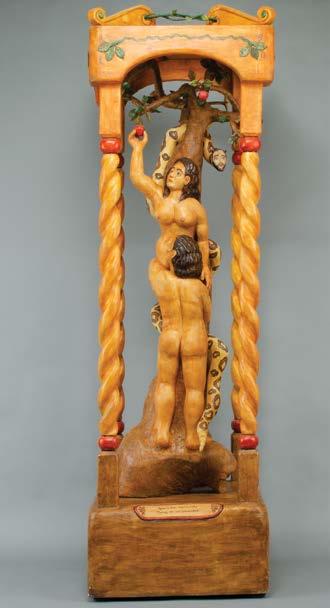
museumfoundation.org | 11
Large-scale alebrijes by Santa Fe artist Rick Phelps were part of an Axle Contemporary mobile exhibition. Photo courtesy Museum of International Folk Art.
Bulto of Adam and Eve by Carlos José Otero. Collection of the Museum of International Folk Art. Photo courtesy Museum of International Folk Art.
The Nature of Glass
Reflecting an Artistic Tradition through Time
Once pigeonholed as a craft, glass art has enjoyed a growing audience during the past several decades among museums, scholars and collectors alike. The United Nations even declared 2022 as The Year of Glass.
Exhibitions—such as The Nature of Glass, on view at the New Mexico Museum of Art through December 31, 2023, and the recent Clearly Indigenous: Native Visions Reimagined in Glass at the Museum of Indian Arts and Culture—have helped shift this perception, making the medium more accessible to the public. As Matthew Kangas wrote in 1999 in Glass Magazine, “the paradox of glass art is the question of how such a traditional material can ever carry contemporary subject matter.”
In Santa Fe, glass as fine art dates to 1968 when the first glass works studio and gallery opened on Canyon Road. In 1974, renowned glass artist Dale Chihuly founded a glass studio at the Institute of American Indian Arts. Appropriately, Chihuly's work is included in The Nature of Glass
The museum has “a wonderful opportunity to share its collection of contemporary art glass, as well as work from significant glass collectors here in Santa Fe who have generously loaned pieces to the exhibition,” says Christian Waguespack, the museum’s head of curatorial affairs and curator of 20th century art.
According to Waguespack , the 28 works selected from the museum’s art glass collection represent fresh, innovative approaches to a medium that dates back more than 4,000 years to ancient Mesopotamia.
Among featured artists are Terri Greeves (Kiowa) and Preston Singletary (Tlingit), both of whom reimagine Indigenous motifs. Greeves reconceptualizes traditional beaded leather moccasins in her 2006 Yee Tah-lee, a pair of size 13 Converse high tops covered in beaded pop imagery. Singletary’s 1999 Wasco, reflects a mythical sea creature in a contemporary light.
Working in glass, says Singletary, “transforms the notion that Native artists are only best when traditional materials are used.”
The contemporary impulse married to traditional techniques is also seen in Robert Wilson’s Hotworked Glass, from 1994. Wilson, classically trained at the Corning Museum of Glass, later worked with Murano glassmakers in Italy, innovating the novel method of sculpting molten glass into a solid object while still in the furnace.

For his part, Mark Zippel pioneered kiln-fired glass. His starkly white, ovoid Polar Cap, from 2004, looks like an Artic ice cap. The work, he says, examines climate change in “a convergence between art and science.”
To support the New Mexico Museum of Art, contact Kristin Graham at Kristin@museumfoundation.org or 505.216.0826.
12 | museumfoundation.org
William Morris, Artifact Still Life, 1990. Blown glass, clear with scavo and gold leaf. Collection of the New Mexico Museum of Art. Gift of Dr. Donn and Pamela Duncan. Photo courtesy New Mexico Museum of Art.
Ginny Ruffner also embraces the continuum of life and science in her 1991 Eve and Pink Sticks. Here, she employs borosilicate glass, the kind of glass used to make scientific test tubes and beakers, to sculpt the biblical figure of Eve in a hyper-stylized Garden of Eden.
In Artifact Still Life, from 1990, William Morris chemically treats his glass to create what looks like recently excavated, weathered “bones.” The work recalls life’s fragility, a kind of memento mori, a reminder of death’s inevitability.
Finally, in her 2001 work, I Feel Strange, Sylvia Levinson addresses her ever-timely concerns about rising authoritarian politics in Argentina. In her faceless portrait, a glass “blonde wig” floats untethered on the wall, recalling the tragedy of the disappeared, a theme that echoes far beyond Argentinian borders.
Private exhibition support for The Nature of Glass through the Museum of New Mexico Foundation is helping further the glass art movement in Santa Fe and beyond, says Waguespack.

“New Mexico has a robust community of glass artists and patrons,” he says. “We are excited for the chance to show that our museum is a place for these communities and this work.”
What's New in the Collection
Marc Quinn, one of the famed Young British Artists of the 1980s, explores the human form through surreal imagery and unconventional materials.
In Intuitive Morphology, a multipart sculpture of mirrored glass, recognizable body parts cast from Quinn’s own body are mixed with other biomorphic shapes, suggesting a human body dissolving into or forming out of mercury-like puddles.
Santa Fe contemporary art collector Bobbie Foshay donated Intuitive Morphology to the New Mexico Museum of Art, along with another 40 significant works. She also provided significant support for the Vladem Contemporary, including funding for the museum’s Window Box displays and for an LED light installation on the building’s façade by internationally renowned, Albuquerqueborn artist Leo Villareal.

museumfoundation.org | 13
Marc Quinn, Intuitive Morphology, 1998. Silver and blown and cast glass in eight parts. Collection of the New Mexico Museum of Art. Gift of Bobbie Foshay, 2019. Photo courtesy New Mexico Museum of Art.
Frederick Hammersley, Self-portrait, 1957. Stained glass on magnesite. Collection of the New Mexico Museum of Art. Gift of Frederick Hammersley Foundation, 2017. Photo courtesy New Mexico Museum of Art.
History and Heritage
A Century of Indian Market
A century of Native American art is on view at the New Mexico History Museum through August 31, 2023.
Honoring Tradition and Innovation: 100 Years of Santa Fe’s Indian Market 1922-2022 features more than 200 works by Indian Market artists, celebrating the artists and collectors who have made Indian Market possible.
“Santa Fe’s Indian Market was created to preserve and perpetuate the cultural heritage of Native Americans,” says Cathy Notarnicola, the museum’s curator of Southwest history.

Indian Market’s arc of creative endeavor is demonstrated in a chronological progression, beginning with the earliest works made for the inaugural 1922 Indian Market. The historic examples in the exhibition link Native art traditions to contemporary voices of today, demonstrating that neither are isolated in the past. Each is distinctively individual and continuously evolving.
The show arrives at the present day showcasing works by Native artists who grew up straddling their traditional cultures and the popular culture of the modern world.
Viewers know they are entering new territory with the works of contemporary jewelers Charles Loloma (Hopi) and Denise Wallace (Chugach Aleut), who added novel materials like fossilized ivory, precious stones and rare woods to traditional jewelry.
Tony Da (San Ildefonso Pueblo), grandson of master potter Maria Martinez, innovated his pottery with sgraffito etching, inlaid stones and bands of heishi. His highly stylized iconography, as seen in Bear, from 1978, was inspired by ancient Mimbres pottery he studied at Western New Mexico University.
Native storytelling reaches its contemporary apex in the exhibition as various artists reinterpret Western comic books from Indigenous points of view. In Diego Romero’s 2003 bowl, Double Take, the Cochiti Pueblo artist honors his ancestors' methods, techniques and forms of coiling clay while incorporating comic book-inspired imagery to address Native social issues.
Jason Garcia (Santa Clara Pueblo) also employs comic art. His 2008 print, Tewa Tales of Suspense #5: Behold… Po’pay!, re-fashions Superman as a towering Native superhero. “Comics are another way of creating and teaching stories and traditions to a greater audience," Garcia says.
Indian Market’s reach to tribes beyond the Southwest is demonstrated with works by such artists as Passamaquoddy basket maker Jeremy Frey. For this seventh-generation artist, baskets are a necessity in his small Maine
Eagle Dancers performing at Indian Market, Santa Fe, New Mexico, 1991. Courtesy Palace of the Governors Photo Archives, Neg. no. HP.2014.14.676.
14 | museumfoundation.org
To support the New Mexico History Museum, contact Alex Wilson at 505 216.1592 or Alex@museumfoundation.org.
fishing town. In 2011, his porcupine quill and sweetgrass basket was the first basket ever to win Indian Market’s Best of Show award.
“I’m helping put basketry on the map,” Fry says. “I try to do cutting-edge, but I don’t want to go far away from what my tribe has given me for an art form.”
The exhibition also emphasizes the importance of collectors in the century-long continuum of Indian Market. Thirty-three objects from the collection of JoAnn and Bob Balzer are on loan to the museum, showcasing their more than 50 years of Indian Market purchases.
“While all of our pieces are special, the most special is Jody Naranjo’s pot, Indian Market Daze,” says JoAnn Balzer. “It tells a story about Indian Market, with various Indian Market scenes all over. One is of Kathleen Wall, another is frybread, there is the Cathedral, the fashion show, the children. When we look at this pot, it reminds us of all our fond Indian Market memories.”
New on View from the Collection
Silver and Stones: Collaborations in Southwest Jewelry, currently on display in the New Mexico History Museum’s Palace of the Governors, showcases for the first time ever an unusual jewelry collection from the 1940s and 1950s. The collection exemplifies the beneficial economic relationship between Diné (Navajo) silversmith David Taliman and merchant William C. Ilfeld.
William C. Ilfeld was the grandson of the Jewish pioneer Charles Ilfeld, who emigrated to New Mexico from Germany in 1865.
William managed the Native American jewelry department at the family’s department store in Las Vegas. Taliman worked in several trading post shops, including Maisel’s in Albuquerque and Julius Gan’s Southwest Arts and Crafts in Santa Fe.
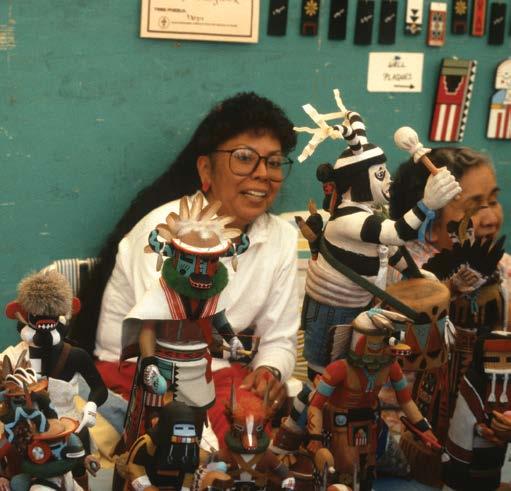
Ilfeld’s designs were produced by Taliman, who often used stones from Ilfeld’s personal collection. The necklace above is part of the jewelry collection donated by Ilfeld to the New Mexico History Museum in 1971.

museumfoundation.org | 15
Necklace by silversmith David Taliman, donated to the New Mexico History Museum by William C. Ilfeld. Photo courtesy New Mexico Department of Cultural Affairs.
Hopi Artist Elsie Talahytewa at Santa Fe Indian Market, Santa Fe, New Mexico, 1991. Photo © Annie Sahlin. Courtesy Palace of the Governors Photo Archives, Neg. no. HP.2013.12.081.
Invaluable Partnerships
Historic Site Hosts Artists in Residence
Through its Art in Public Places program, New Mexico Arts, a division of the New Mexico Department of Cultural Affairs, commissions artists to create large-scale, site-specific projects throughout the state. By definition, these works are contemporary, even if they often refer to times in the near or distant past.
New Mexico Historic Sites is a frequent Art in Public Places partner. Art installations at the sites include works by artist Deborah Jojola (Isleta Pueblo/Jemez Pueblo) at Coronado Historic Site and by Sean Rising Sun Flanagan (Taos Pueblo) at both Jemez Historic Site and Fort Selden Historic Site. A collaborative project also debuted during the reopening of Bosque Redondo Memorial at Fort Sumner Historic Site in May of 2022.
This summer, New Mexico Arts launches a second project at Bosque Redondo—an artist-in-residence program. Two separate residencies will bring two artists to live and work at the site.
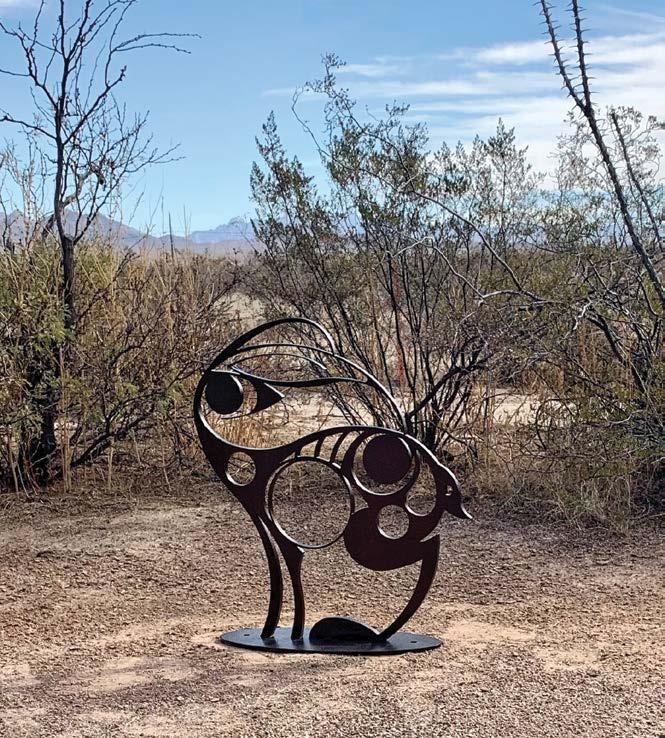
“There’s nothing more contemporary, more of the moment, than works of art created by the artists selected to participate in our inaugural artist-in-residence program,” says Michelle LaFlamme-Childs, executive director of New Mexico Arts.
New Mexico Historic Sites Executive Director Patrick Moore describes the sites’ partnerships with other state agencies, Museum of New Mexico divisions, schools and universities. “They are invaluable,” he says. “They open new funding opportunities, strengthen our programs, extend our programmatic reach while often lowering costs, and jointly create synergies to enhance marketing efforts.”
A selection committee considered the proposals for Bosque Redondo, judging how well the artist addresses the shared history of communities surrounding the site. A public component to be shown upon the residency’s completion is also required.
“When words are not enough for storytelling, these visual artists will provide a voice to words long silenced by trauma," says site manager Aaron Roth, speaking to the tragic history of the Bosque Redondo, the reservation where Diné (Navajo) and N’de (Mescalero Apache) were forced to live from 1863 to 1868.
To support the New Mexico Historic Sites, contact Alex Wilson at 505.216.1592 or Alex@museumfoundation.org.
Desert Rabbit by Sean Rising Sun Flanagan (Taos Pueblo) at Fort Selden Historic Site. Photo courtesy New Mexico Arts.
16 | museumfoundation.org
The first six-week residency was awarded to actor, screenwriter and film producer DezBaa’ Henderson (Diné) for a project on which she is working with her father, David Henderson (Diné). The elder Henderson, a Navy veteran and Los Alamos National Laboratory retiree, is currently enrolled as a film and digital media arts student at Northern New Mexico College.
DezBaa’ will edit six weeks’ worth of video of her father rediscovering his Diné heritage, as well as interviews with Bosque Redondo staff, Long Walk historians, medicine people and others in surrounding communities. The resulting short documentary will be on view for visitors to the site.
The second six-week residency was awarded to interdisciplinary artist Dakota Mace (Diné). For her project, she, too, will explore themes of family lineage, community and identity. Her multidisciplinary, short-term installation will combine photography, video, audio and performance.

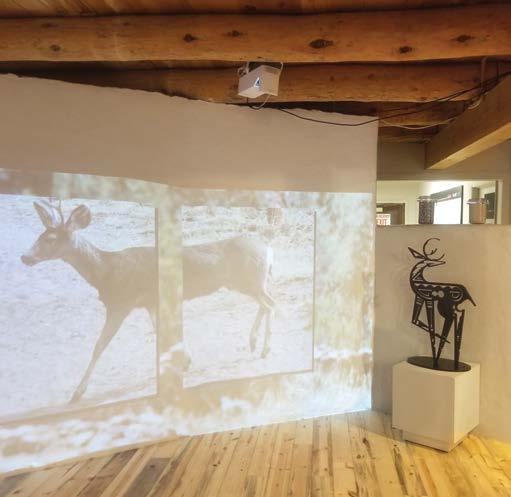
“My project will look at the importance of land and place,” says Mace, “the relationship that we, as Diné, still communicate with our ancestors and the memory or imprint they left within the land.”
LaFlamme-Childs says the inaugural year of the artist-in-residence program is fully funded with a $28,000 appropriation from the New Mexico State Legislature. With additional funds from the state and private sources via the Museum of New Mexico Foundation, she hopes to expand this program to other historic sites throughout the state.
museumfoundation.org | 17
There’s nothing more contemporary, more of the moment, than works of art created by the artists selected to participate in our inaugural artist-in-residence program.
Northern Deer by Sean Rising Sun Flanagan (Taos Pueblo) at Jemez Historic Site. Photo courtesy New Mexico Arts.
A youth participates in an art project by artist Mark Host. Photo courtesy New Mexico Arts.
Archaeology Goes Hollywood
OAS Shawls Make Film Debut
The shining talents of the employees at the New Mexico Office of Archaeological Studies and members of Friends of Archaeology will soon be coming to a silver screen near you—in a new feature film, Here, by famed director Robert Zemeckis featuring Hollywood superstar Tom Hanks.
For the past several weeks, OAS educator and archaeologist Mary Weahkee (Comanche/Santa Clara Pueblo), her grandchildren and several OAS employees, interns and volunteers have been hard at work creating a six-by-two-foot turkey feather shawl to be featured in the film. Another team of OAS supporters has also spent hours crafting an additional eight-by-twofoot rabbit fur shawl.

Both shawls will be showcased as traditional costumes in the upcoming film, which in addition to Hanks, stars Kelly Reilly, Robin Wright and Paul Bettany. Director Zemeckis is best known for his directorial work on the Back to the Future trilogy, Forest Gump and Contact
Currently in production in the United Kingdom, Here is based on a 2014 graphic novel written and illustrated by Richard McGuire. The work features the comings and goings of people throughout history, in a single room, over thousands of years, from 500 BCE to 2033 CE.
To support the Office of Archaeological Studies, contact Lauren Paige at 505.982.2282 or Lauren@museumfoundation.org.
Mary Weahkee (Comanche/Santa Clara Pueblo), Office of Archaeological Studies educator and archaeologist, sorts feathers for a turkey feather shawl to be worn in the movie Here. Photo by Melissa Martinez.
18 | museumfoundation.org
Story by Melissa Martinez.
OAS staff and volunteers were given three weeks to complete the two shawls. The turkey feather shawl required the creation of several hundred feet of yucca cordage, which Weahkee and Friends of Archaeology board member Eric Blinman wound, by hand, over the course of a few days. "Our legs looked like hamburger meat," says Weahkee.
The pelts of a least 28 rabbits had to be cut into narrow strips for the production of one shawl. The turkey feather shawl required the plucking of a large number of turkeys, yielding thousands of feathers.
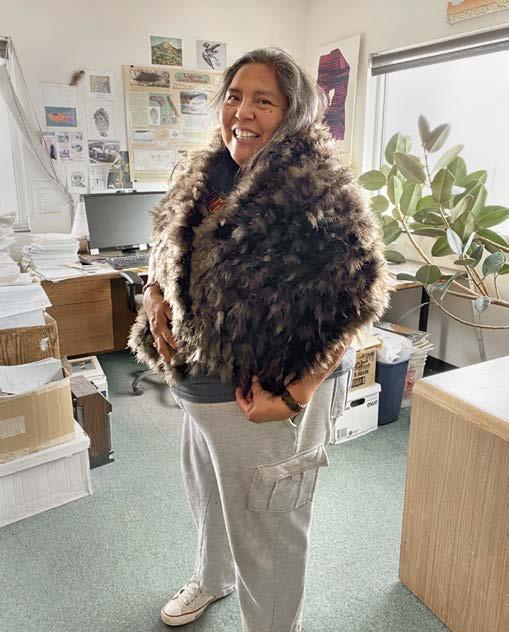
"Only one person can wind feathers at a time," Weahkee says. "I was only able to do maybe ten to 15 feet a day. I was up until four or five o'clock in the morning winding cord, winding feathers."
Custom-made wooden frame looms were created for weaving each piece, and both were completed in early March. Soon after, they were carefully packaged and shipped to the film production crew, arriving in the UK in near-record time.
A release date for Here is yet to be announced, but when filming comes to an end, the shawls will be returned to OAS, where they will be used in educational outreach programs.
Join Friends of Archaeology
You don’t have to be a scientist to experience the fascinating archaeology of New Mexico and the greater Southwest. Membership in Friends of Archaeology is free with a Museum of New Mexico Foundation membership and is your opportunity to dig deep into the past while supporting the Office of Archaeological Studies.
Members enjoy exclusive invitations to interact with archaeologists in an annual series of stimulating statewide field trips, lectures, volunteer fieldwork and other activities.
A Foundation membership is required before joining a Friends group. If you are currently a Foundation member and would like to join FOA, please call 505.982.6366 ext. 100.
museumfoundation.org | 19
Only one person can wind feathers at a time. I was only able to do maybe ten to 15 feet a day. I was up until four or five o'clock in the morning winding cord, winding feathers.
Mary Weahkee (Comanche/Santa Clara Pueblo) models her handmade turkey feather shawl. Photo by Melissa Martinez.
CORPORATE PARTNER SPOTLIGHT
Gathering and Growing
Santa Fe Office of Economic Development
If one was to paint a picture of Economic Development in Santa Fe, every industry would come in its own color of infrastructure with visuals depicting many moving parts.

Within the creative economy, the state museums are among the most colorful and complex, playing a lead role in both supporting and feeding the arts and culture industry.
“The creative industry is what we call a targeted industry that we want to support and develop in the city,” says Johanna Nelson, director of the City of Santa Fe Office of Economic Development. “The Museum of New Mexico Foundation is one very important piece. By supporting the Foundation, we’re supporting some of the biggest players in the industry.”
Nelson took on her role at the Office of Economic Development in early 2023. It is one division within Community Development, which also includes the offices of Affordable Housing, Arts and Culture, Planning and Land Use and Tourism. Nelson says their recently revitalized staff of eight now has the capacity to collaborate and work holistically with organizations across the city, in order to foster economic growth in Santa Fe.
“We’re really looking at this question of how you actually develop an industry,” she says. “It’s complex. There are the businesses, the foundations. There are the technical assistance providers who support the non-profits. And then there’s higher education, the arts collectives and think tanks, the tech sector, and on and on. You learn to look at each industry as an eco-system—or as an entire universe.”
As new Corporate Partners of the Foundation at the $5,000 level, Nelson and her team are looking forward to hosting networking events, entrepreneurial sessions, and a speaker series in some of the cultural spaces available at the Foundation’s Shonnard campus.
Though they are still planning their calendar, they are also considering utilizing various museum meeting rooms and auditoriums. Courtyards and outdoor areas at the museums may be ideal for collaborative events, such as Beyond Profit: A Think + Do Series for Courageous Entrepreneurs, coordinated by Creative Santa Fe, or Santa Fe Innovates, a business accelerator program for start-ups.
By gathering diverse constituents with overlapping interests together on the grounds of such venerated institutions, Nelson says, her office’s mission will grow more firmly rooted in the community.
“What makes the City Different different is our heritage. Our local museums house, preserve and keep that heritage alive. It’s a great fit for both of us.”
To learn more about becoming a Corporate Partner, contact Mariann Lovato at Mariann@museumfoundation.org or 505.216.0849.
20 | museumfoundation.org
An aerial view of the city of Santa Fe. Photo courtesy New Mexico Tourism Department.
Staff
EXECUTIVE OFFICE
Jamie Clements CEO/President Jamie@museumfoundation.org
HUMAN RESOURCES
Rachel Saiz Human Resources/Employee Relations Officer Rachel@museumfoundation.org
DEVELOPMENT
Kristin Graham Director of Development, New Mexico Museum of Art Vladem Contemporary Kristin@museumfoundation.org
Lauren Paige Director of Development, Museum of Indian Arts and Culture Office of Archaeological Studies Lauren@museumfoundation.org
Laura Sullivan Director of Development, Museum of International Folk Art Laura@museumfoundation.org
Alex Wilson Director of Development, New Mexico History Museum, New Mexico Historic Sites Alex@museumfoundation.org
Stephanie Wilson Development Associate Stephanie@museumfoundation.org
MEMBERSHIP AND COMMUNICATIONS
Saro Calewarts Creative Content Manager Saro@museumfoundation.org
Mariann Lovato Director of Membership and Communications Mariann@museumfoundation.org
Olivia McLendon Digital Marketing Manager Olivia@museumfoundation.org
Cara O’Brien Director of The Circles and Circles Explorers Cara@museumfoundation.org
Brittny Wood Membership and Annual Fund Manager Brittny@museumfoundation.org
FINANCE
Eduardo Corrales Gifts and Records Administrator Eduardo@museumfoundation.org
Tammie Crowley Finance Manager Tammie@museumfoundation.org
Georgine Chavez Vice President of Finance Georgine@museumfoundation.org
Sachiko Hunter-Rivers Database Manager Sachiko@museumfoundation.org
Jeanne Peters Finance Assistant Jeanne@museumfoundation.org
RETAIL OPERATIONS
Teresa Curl Vice President of Retail Teresa@museumfoundation.org
Krista Kernek Receiving Administrator Krista@museumfoundation.org
Susie Little Merchandising Administrator Susie@museumfoundation.org
George Mayer Driver and Warehouse Assistant George@museumfoundation.org
Kylie Strijek Buyer and Website Manager Kylie@museumfoundation.org
Jonah Smith Inventory Administrator Jonah@museumfoundation.org
MUSEUM SHOPS
Vince Gioielli Shop Manager Spiegelberg Shop at the New Mexico History Museum Histshop@museumfoundation.org
Rosalie D. and Steven J. Harris Shop at the New Mexico Museum of Art Artshop@museumfoundation.org
Christine Jaeger Shop Manager
Lynn Godfrey Brown Shop at the Museum of International Folk Art Folkshop@museumfoundation.org
Felipita Ortiz Shop Manager
Colleen Cloney Duncan Museum Shop at the Museum of Indian Arts and Culture Miacshop@museumfoundation.org
LICENSING
Pamela Kelly Vice President of Licensing and Branding Pamela@museumfoundation.org
Ways to Give
MEMBERSHIP
Support the Museum of New Mexico Foundation in delivering essential services to our 13 partner cultural institutions while offering enjoyable member benefits.
THE CIRCLES
Participate in a series of exclusive events while providing leadership-level support.
CIRCLES EXPLORERS
Support and explore the art, culture and history of New Mexico through active, adventurous, and educational cultural excursions and experiences.
CORPORATE PARTNERS AND BUSINESS COUNCIL
Support the museums through your business and receive recognition and member benefits for your business, clients and employees.
ANNUAL FUND
Provide critical operating support for the Museum of New Mexico Foundation to fulfill its mission on behalf of our 13 partner cultural institutions.
EXHIBITION DEVELOPMENT FUNDS
Support exhibitions, related programming and institutional advancement at the division of your choice.
EDUCATION DEVELOPMENT FUNDS
Fund museum education and public outreach programs at our four museums, eight historic sites and the Office of Archaeological Studies.
PLANNED GIVING
Provide a long-lasting impact at our 13 partner cultural institutions through an estate gift, bequest, charitable gift annuity or gift of art.
ENDOWMENT FUNDS
Establish a new fund, or add to the principal of an existing fund, to provide a reliable source of annual income that sustains a variety of cultural programs and purposes.
SPECIAL CAMPAIGNS
Give to special campaign initiatives designed to fund a range of capital expansions and programming advances throughout the Museum of New Mexico system.
For more information, visit museumfoundation.org/give.
museumfoundation.org | 21
The Art of Miracles
Votive offerings were used in the ancient world for help or protection. Beautiful on their own or used to create ornately decorated works of art, these folk art miracles are sure to bring blessings and good fortune.


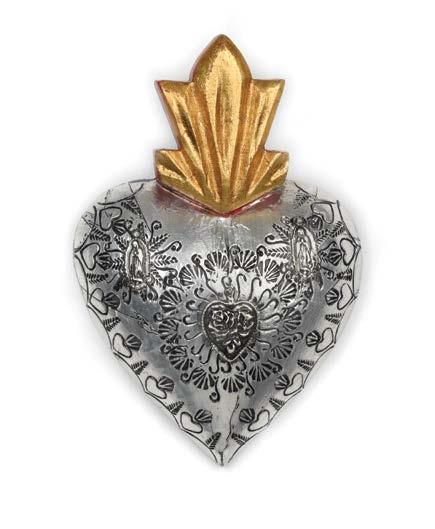
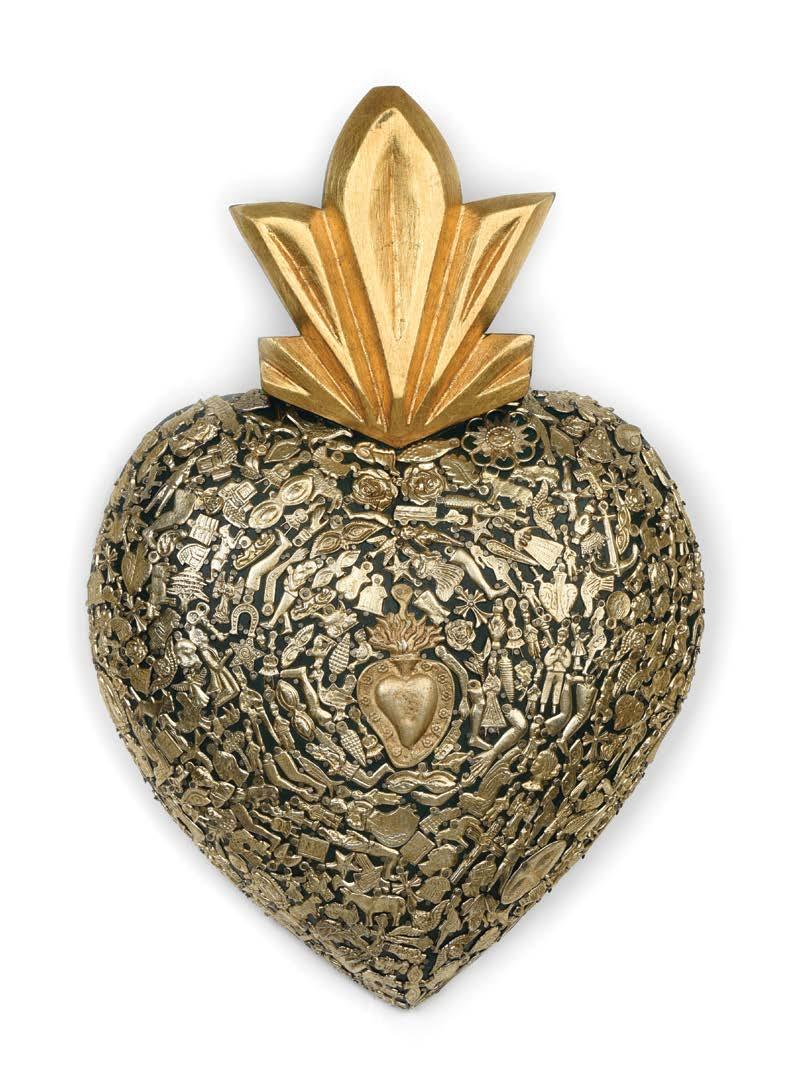
shopmuseum.org































